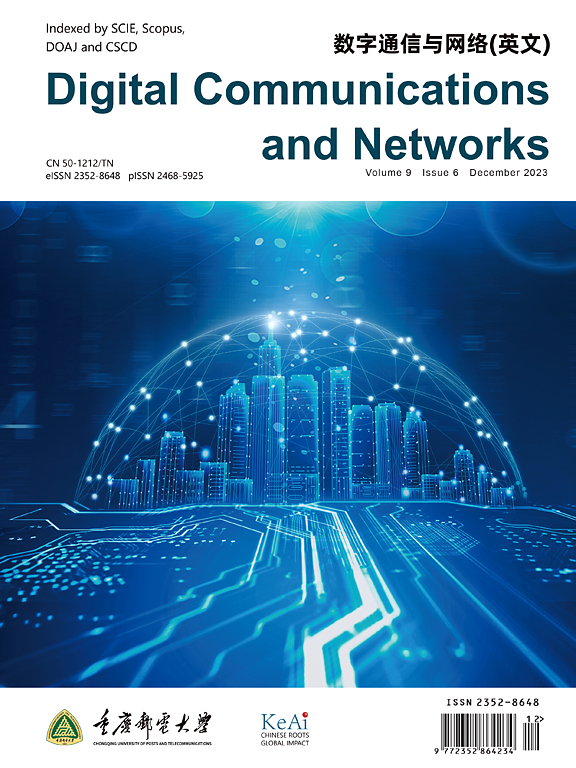增强6G及以上的灵活性和系统性能:基于用户的数字命理学和波形方法
IF 7.5
2区 计算机科学
Q1 TELECOMMUNICATIONS
引用次数: 0
摘要
混合数字数字OFDM (MN-OFDM)系统在6G及以后是必不可少的。然而,由于数字命理学之间的干扰(INI),它遇到了挑战。即将推出的6G技术旨在支持具有高数据速率、低延迟和可靠性的创新应用。因此,有效地处理INI对于满足这些应用程序的不同需求至关重要。为了解决MN-OFDM系统中的INI,本文提出了一种基于用户的数字和波形(UBNW)方法,该方法使用各种基于ofdm的波形及其参数来缓解INI。通过为每个用户分配特定的波形和数字,UBNW减轻了INI,优化了服务特性,并有效地满足了用户需求。所需的保护带(GB),表示为用户带宽的比率,在25 dB的SIR下,在不同的波形之间变化很大。例如,OFDM- fofdm只需要2.5%,而OFDM- ufmc、OFDM- wola和传统OFDM分别需要7.5%、24%和40%。不同波形的时频效率也不同。FOFDM达到85.6%,UFMC达到81.6%,WOLA达到70.7%,传统OFDM达到66.8%。仿真结果表明,UBNW方法不仅有效地缓解了INI,而且提高了系统的灵活性和时频效率,同时降低了所需的GB。本文章由计算机程序翻译,如有差异,请以英文原文为准。
Enhancing flexibility and system performance in 6G and beyond: A user-based numerology and waveform approach
A Mixed Numerology OFDM (MN-OFDM) system is essential in 6G and beyond. However, it encounters challenges due to Inter-Numerology Interference (INI). The upcoming 6G technology aims to support innovative applications with high data rates, low latency, and reliability. Therefore, effective handling of INI is crucial to meet the diverse requirements of these applications. To address INI in MN-OFDM systems, this paper proposes a User-Based Numerology and Waveform (UBNW) approach that uses various OFDM-based waveforms and their parameters to mitigate INI. By assigning a specific waveform and numerology to each user, UBNW mitigates INI, optimizes service characteristics, and addresses user demands efficiently. The required Guard Bands (GB), expressed as a ratio of user bandwidth, vary significantly across different waveforms at an SIR of 25 dB. For instance, OFDM-FOFDM needs only 2.5%, while OFDM-UFMC, OFDM-WOLA, and conventional OFDM require 7.5%, 24%, and 40%, respectively. The time-frequency efficiency also varies between the waveforms. FOFDM achieves 85.6%, UFMC achieves 81.6%, WOLA achieves 70.7%, and conventional OFDM achieves 66.8%. The simulation results demonstrate that the UBNW approach not only effectively mitigates INI but also enhances system flexibility and time-frequency efficiency while simultaneously reducing the required GB.
求助全文
通过发布文献求助,成功后即可免费获取论文全文。
去求助
来源期刊

Digital Communications and Networks
Computer Science-Hardware and Architecture
CiteScore
12.80
自引率
5.10%
发文量
915
审稿时长
30 weeks
期刊介绍:
Digital Communications and Networks is a prestigious journal that emphasizes on communication systems and networks. We publish only top-notch original articles and authoritative reviews, which undergo rigorous peer-review. We are proud to announce that all our articles are fully Open Access and can be accessed on ScienceDirect. Our journal is recognized and indexed by eminent databases such as the Science Citation Index Expanded (SCIE) and Scopus.
In addition to regular articles, we may also consider exceptional conference papers that have been significantly expanded. Furthermore, we periodically release special issues that focus on specific aspects of the field.
In conclusion, Digital Communications and Networks is a leading journal that guarantees exceptional quality and accessibility for researchers and scholars in the field of communication systems and networks.
 求助内容:
求助内容: 应助结果提醒方式:
应助结果提醒方式:


